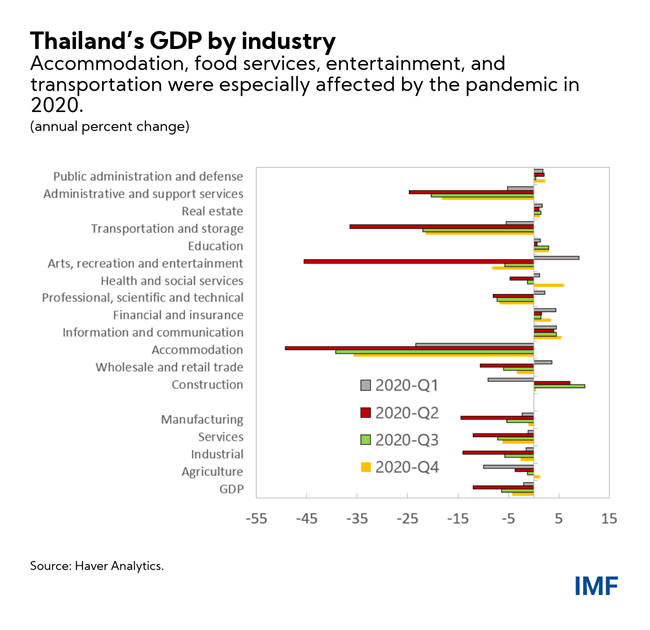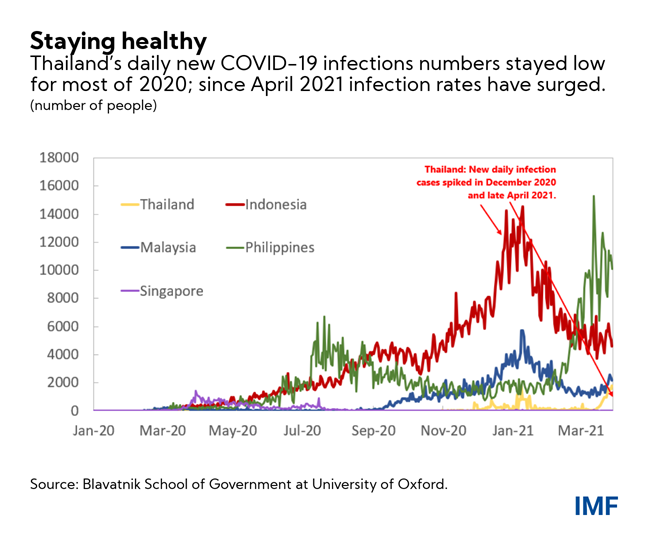Like many countries, Thailand’s economy was hit hard by the COVID-19 pandemic last year. The country’s GDP fell by over 6 percent in 2020 and many workers, especially those related to the tourism sector, lost their jobs.
Related Links
This was despite decisive action on the government’s part to implement a package of fiscal, monetary, and financial policies to mitigate the impact of the virus on the country. According to the IMF’s latest annual assessment or Article IV consultation, Thailand’s economy is forecast to grow at 2.6 percent in 2021, and a surge in COVID‑19 infections in the country and the region since the beginning of the year highlights the uncertainty about the path of the pandemic and the importance of continued efforts to contain the spread of the virus for a strong and durable recovery.
Here are five things to know about Thailand’s recent economic challenges and prospects for the recovery:
- The pandemic precipitated a sudden stop in tourism flows and a significant contraction in economic activity. Thailand’s GDP fell by 6.1 percent in 2020, the largest contraction since the Asian financial crisis. The tourism sector, which accounts for about a fifth of GDP and 20 percent of employment, has been especially affected by the cessation of tourist travel. Low-skilled workers and informal and migrant workers have been hit hard, particularly women and the youth, who have suffered disproportionately from diminished employment opportunities in contact-intensive sectors bearing a significant burden of the layoffs observed in 2020. The financial sector has thus far weathered the pandemic well, but stress has been building up in the small and medium enterprises sector.
- The government responded boldly to mitigate the crisis. Timely and stringent containment measures introduced by the authorities successfully flattened the infection curve during most of 2020. Effective containment, along with a timely and multipronged policy package—comprising fiscal stimulus amounting to about 10 percent of GDP; cuts in the policy rate by 75 basis points to its all time low of 0.5 percent, and financial sector measures to buttress the smooth functioning of financial markets and support debtors affected by COVID 19—helped limit the impact. The fiscal support has included health-related spending and assistance to affected households, including those outside the social security system financed by some reprioritization in the fiscal year 2020 budget and an additional borrowing of 1 trillion baht. These measures have saved lives and livelihoods and in part supported an initial recovery by restoring confidence and permitting a pathway to a safe and gradual reopening of activity. However, the fiscal deficit widened to 4.8 percent of GDP in 2020 and public debt-to-GDP ratio increased to 49.6 percent of GDP in 2020 from 41 percent in 2019.
- Dark clouds persist and require flexibility in government policies to build back better and stronger. Economic recovery in 2021 is expected to be sluggish, with growth projected at 2.6 percent in the recently completed 2021 Article IV consultation, and divergent across sectors. Prospects for a near-term recovery are challenged by an aggressive third wave of the pandemic. This environment calls for flexibility and careful coordination among the fiscal, monetary and financial sector policies to adapt to fast changing circumstances. Most important to a resilient recovery at this juncture is the vaccine policy. Accelerating and ensuring adequate distribution of vaccines is critical to attain herd immunity, put an end to the pandemic and lay the groundwork for a strong recovery.
- Mutually reinforcing policies are needed to support the recovery with fiscal policy at the center of the policy response. A premature withdrawal of the support measures would not be prudent before a recovery is well underway. To help accelerate the recovery, a more ambitious fiscal expansion is warranted with spending focused on scaling up of public investment and protecting the vulnerable, including through better targeted social transfers. As the crisis subsides and the recovery strengthens, Thailand will need to initiate a medium-term revenue mobilization strategy to rebuild fiscal buffers and ensure fiscal sustainability. Rebuilding fiscal buffers after the pandemic will require additional effort in both revenue generation and expenditure prioritization. Targeted and more effective financial sector support to hard hit firms and households, complemented with additional monetary accommodation, would also support the recovery.
- Thailand’s dependence on contact-intensive sectors and long-standing structural issues, such as high informality—evident before the pandemic—warrant a strong push to adapt the economy to the post-pandemic world. Further scaling up of investment, particularly for digital infrastructure, combined with improving training and education outcomes and promoting innovation will catalyze the economy’s digital transformation and mitigate the possible long‑term economic damage from the pandemic. The authorities see the crisis as an opportunity to transform the tourism sector from mass and low‑cost to high‑end and low-density tourism, while encouraging domestic tourism, to reduce the sector’s dependence on tourism‑related infrastructure and natural resources. To facilitate a safe reopening for the tourism sector, Thailand added tourism employees as essential workers in the vaccination queue and plans to reopen to international tourists from July 1, under the “Phuket Sandbox” initiative, allowing free movement of fully vaccinated tourists on the island. The COVID‑19 crisis also offers an opportunity to better align development policies with climate objectives to strengthen the recovery and economic resilience, and place Thailand on a firm path to meeting climate mitigation goals. An efficient carbon pricing would encourage a gradual shift to cleaner energy alternatives, reduce greenhouse gas emissions and air pollution, and help in transitioning to a decarbonized economy.




